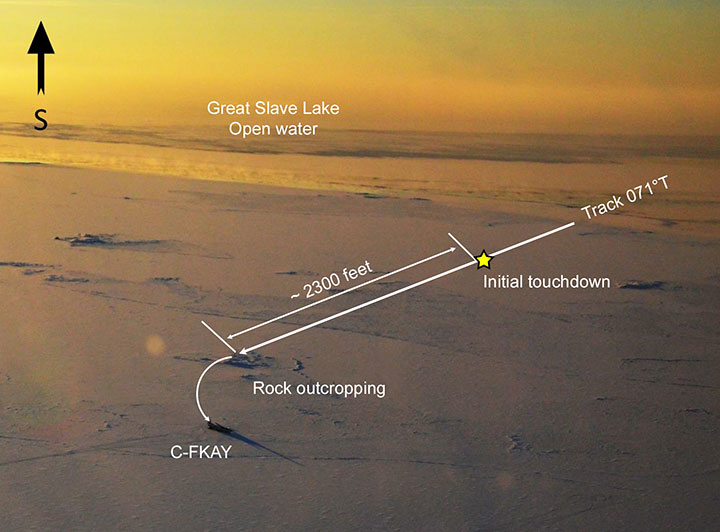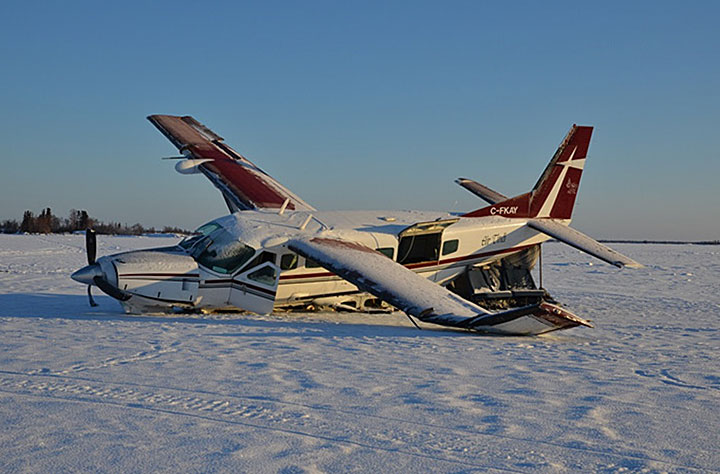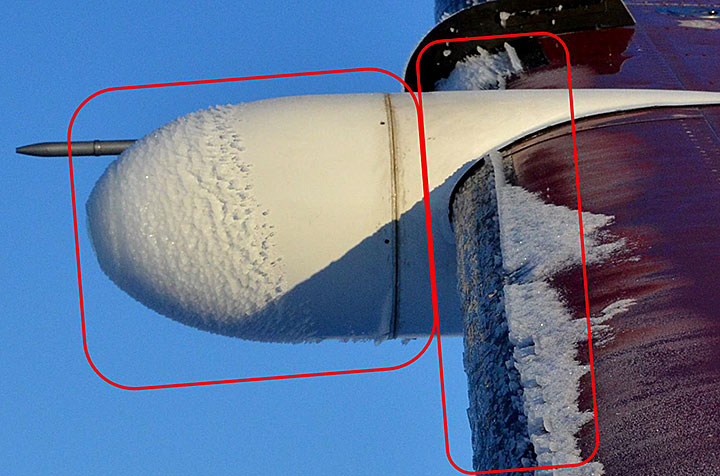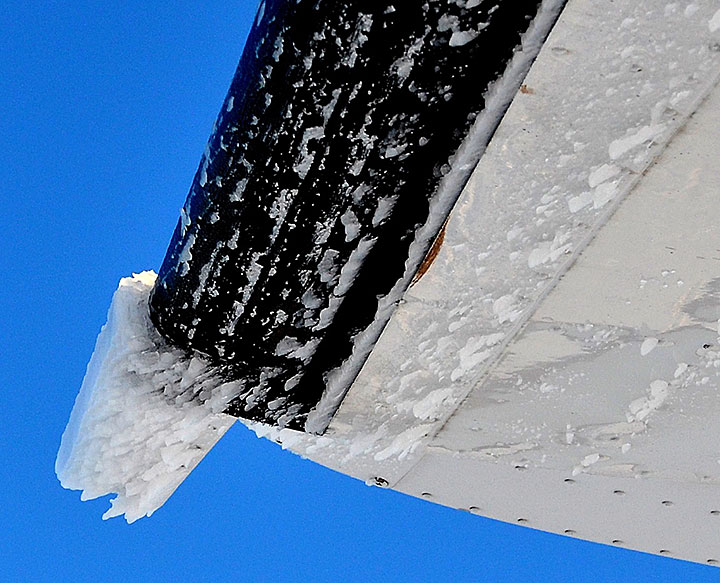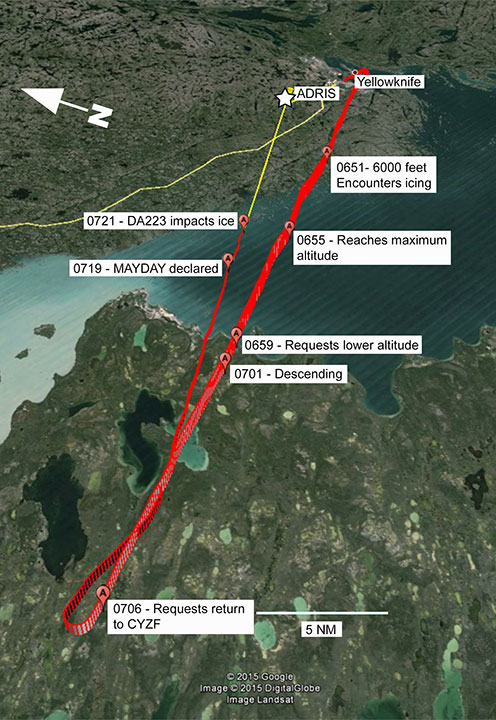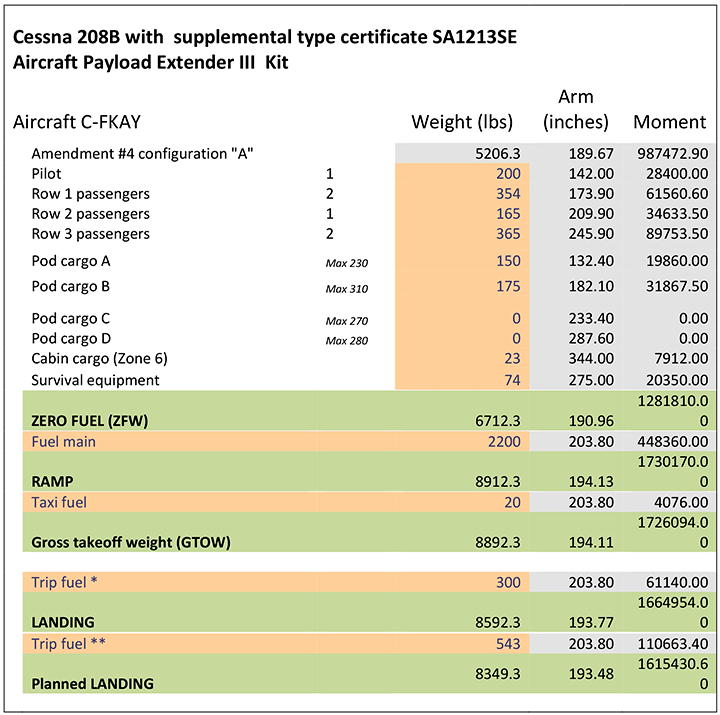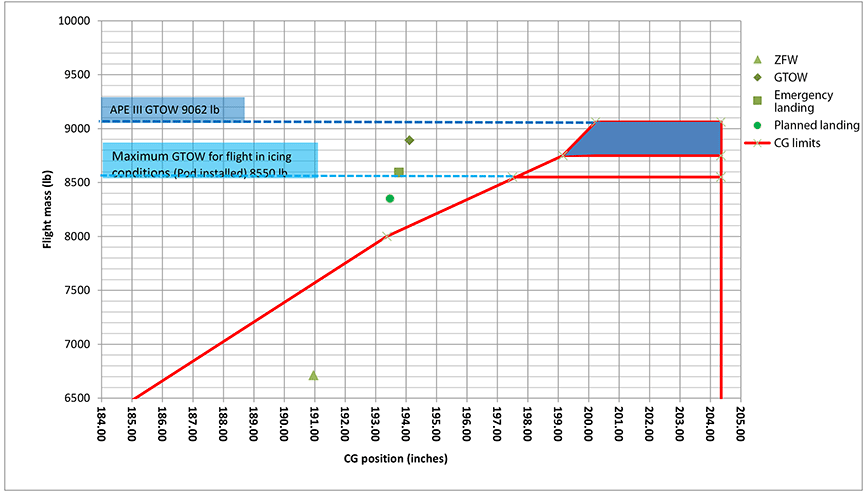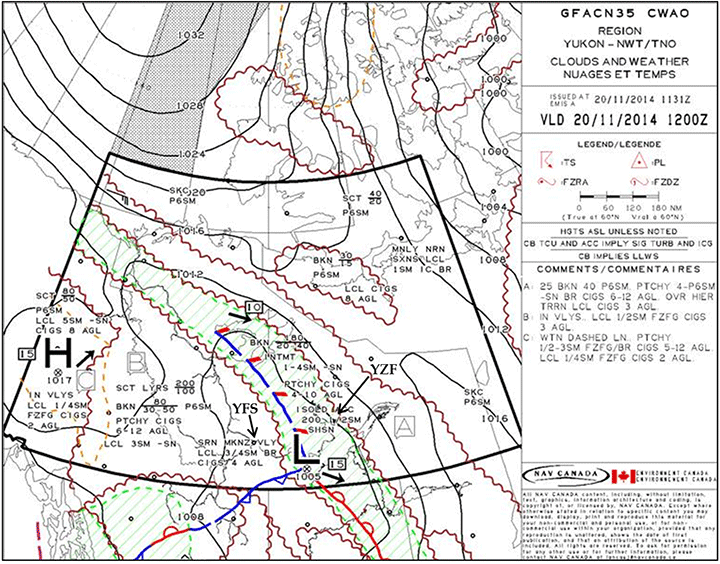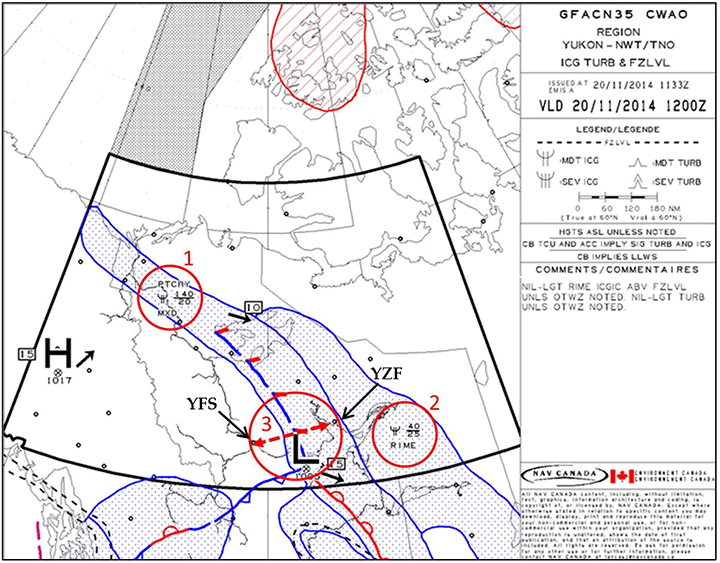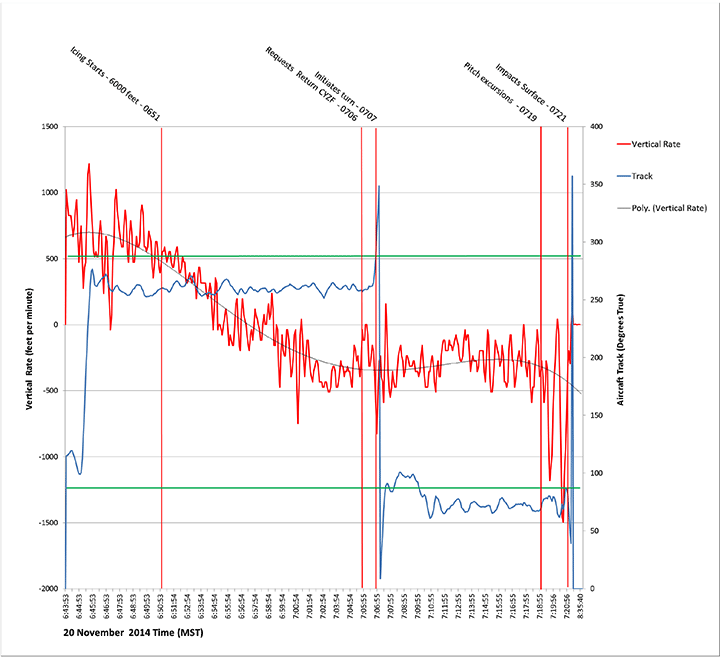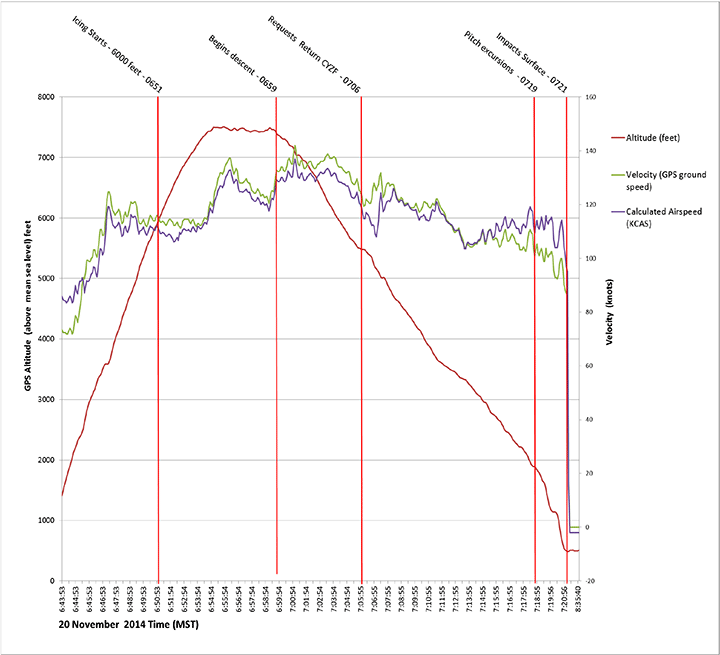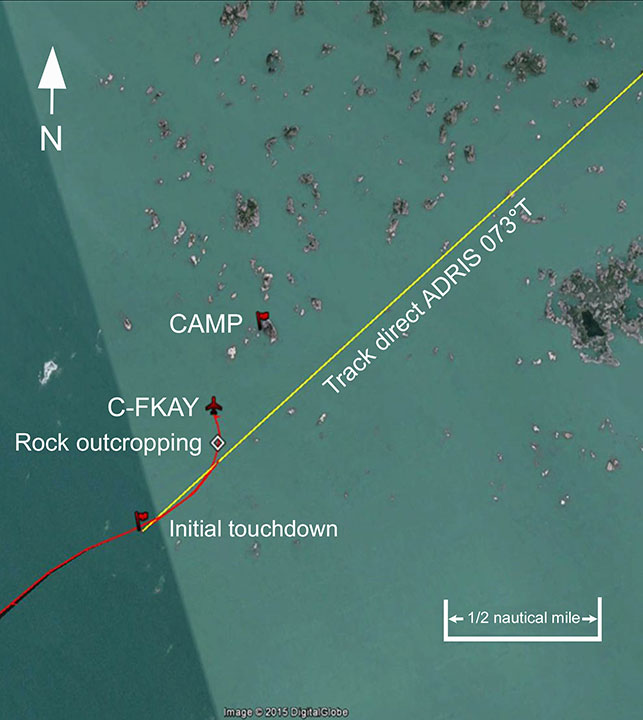Severe icing encounter and forced landing
Air Tindi Ltd.
Cessna 208B, C-FKAY
Yellowknife, Northwest Territories, 18 nm W
The Transportation Safety Board of Canada (TSB) investigated this occurrence for the purpose of advancing transportation safety. It is not the function of the Board to assign fault or determine civil or criminal liability. This report is not created for use in the context of legal, disciplinary or other proceedings. See Ownership and use of content. Masculine pronouns and position titles may be used to signify all genders to comply with the Canadian Transportation Accident Investigation and Safety Board Act (S.C. 1989, c. 3).
Summary
The Air Tindi Ltd. Cessna 208B Caravan (registration C-FKAY, serial number 208B0470), departed Yellowknife Airport, Northwest Territories, on 20 November 2014 at 0642 Mountain Standard Time under instrument flight rules as Discovery Air flight DA223 to Fort Simpson, Northwest Territories. The flight had been rescheduled from the previous night because of freezing drizzle at Fort Simpson. During the climb to 8000 feet above sea level, DA223 encountered icing conditions that necessitated a return to Yellowknife. On the return to Yellowknife, DA223 was unable to maintain altitude. At 0721, flying in darkness approximately 18 nautical miles west of Yellowknife, it contacted the frozen surface of the North Arm of Great Slave Lake. The aircraft sustained substantial damage when it struck a rock outcropping, but there were no injuries to the pilot or to the 5 passengers. The pilot established communication with Air Tindi via satellite phone, and the pilot and passengers were recovered approximately 4 hours after the landing. The emergency locator transmitter did not activate during the landing, but was activated manually by the pilot.
1.0 Factual information
1.1 History of the flight
The Air Tindi Ltd. Cessna 208B (registration C-FKAY, serial number 208B0470) was operating as Discovery Air flight DA223 from Yellowknife Airport (CYZF), Northwest Territories, to Fort Simpson Airport (CYFS), Northwest Territories. The flight had originally been scheduled for 19 November 2014 at 1800Footnote 1 but was cancelled because of freezing drizzle reported in Fort Simpson. The flight was rescheduled for 20 November 2014 at 0600. Its early-morning departure was intended to enable the regularly scheduled return flight (DA222 from CYFS to CYZF) to depart CYFS at 0800 with minimal delay. The aircraft was fueled to 2200 pounds, as it was normal practice to carry extra fuel for the return flight.
The pilot reported for duty at 0500 to prepare for the flight. A pre-flight inspection was performed, wing covers were removed, and no contamination was observed on the wings. The pilot obtained weather information via the Internet and contacted the North Bay, Ontario, Flight Information Centre to file an instrument flight rules (IFR) flight plan. A request for enroute icing condition reports was also made; there were no reported airmen’s meteorological information (AIRMET) and pilot weather report (PIREP)Footnote 2 for the flight-planned route. No other weather information was requested or offered.
Passengers arrived at the Air Tindi terminal at 0600 and were boarded at 0630. A passenger safety briefing, which included information on safety equipment and exit locations, was conducted. Passengers were given a verbal explanation of the operation of the doors and were referred to the passenger safety cards provided. Passenger baggage, along with bulky winter clothing, was loaded into the belly cargo pod.
DA223 departed CYZF at approximately 0642, with an IFR clearance to 8000 feet above sea level (asl) direct to CYFS. During the climb, the aircraft encountered cloud layers; at approximately 0651, flying through 6000 feet asl, it encountered icing conditions. The aircraft continued to climb and levelled off at 8000 feet asl, where cruise power was set. The airspeed did not accelerate beyond 120 knots indicated airspeed (KIAS), and DA223 began to descend with cruise power set.Footnote 3 At 0659, the pilot contacted the Edmonton, Alberta, Area Control Centre (ACC) and requested a lower altitude, as he was unable to maintain 120 KIAS. Edmonton ACC cleared DA223 to 6000 feet asl direct to CYFS. During the controlled descent, airspeed continued to decline below 120 KIAS, even with the application of maximum continuous power. At 0706, a request was made to Edmonton ACC to return to CYZF because of severe icing. DA223 was ultimately cleared to CYZF via ADRISFootnote 4 at 3000 feet asl. At approximately 0710, the pilot advised the Air Tindi system operations control centre, using a company frequency, that DA223 was returning to CYZF, with an estimated time en route of 30 minutes.
The pilot experienced periods of elevator buffeting and uncommanded forward pitch movements during the turn. He continued the descent in order to maintain 110 KIAS. Flap position remained fully up, as the pilot was concerned that movement would further affect tailplane effectiveness.
Edmonton ACC passed control of DA223 to Yellowknife Air Traffic Control (ATC) Tower at 0716. At 0717, the pilot advised Yellowknife Tower that the aircraft was in severe icing conditions and unable to maintain altitude. DA223 was cleared to 2100 feet asl (minimum vectoring altitude). At 0719, the pilot experienced a significant uncommanded pitch forward and advised ATC that DA223 was unable to maintain 2100 feet asl; a Mayday was declared.
At 0720, when the aircraft was 300 feet above ground level (agl), the pilot experienced a series of wing drops and an associated rate of descent of 1200 feet per minute at 100 to 110 KIAS. In response, the power lever was pushed fully forward, exceeding the maximum continuous rating of 1865 foot-pounds of torque. No flap selections were made.
While still in darkness, DA223 contacted the frozen surface of Great Slave Lake at 0721, and continued moving for 2300 feet before it struck a rock outcropping with the nose and left main landing gear. The aircraft came to rest approximately 600 feet from the outcropping and 2900 feet from the initial touchdown point (Figure 1). There were no injuries to the occupants, but the aircraft was severely damaged. There was no post-impact fire.
Passenger evacuation was ordered once the pilot had assessed the situation. Passengers attempted to open the main cabin door but were unable to do so. After several failed attempts to evacuate, the passengers succeeded in exiting via the left cockpit door with the aid of cockpit lighting. Cabin lighting had not been turned on.
1.2 Injuries to persons
There were no reported injuries to the sole crew member or to the 5 passengers. All were taken to hospital for medical assessment and released.
1.3 Damage to aircraft
The extent of damage sustained to the aircraft rendered it beyond economical repair (see section 1.12, Wreckage and impact information).
1.4 Other damage
Not applicable.
1.5 Personnel information
1.5.1 General
| Pilot licence type | Commercial pilot licence – aeroplane |
|---|---|
| Medical expiry date | 01 August 2015 |
| Total flying hours | 3500 |
| Flight hours on type | 1800 |
| Flight hours in the last 7 days | 12.0 |
| Flight hours in the last 30 days | 52.1 |
| Flight hours in the last 90 days | 156.6 |
| Hours on duty prior to the occurrence | 2.0 |
| Hours off duty prior to the work period | 10.5 |
The pilot had joined Air Tindi on 09 July 2012 and had accumulated a total flight time of approximately 3500 hours on various aircraft types, including the Cessna 150, 172, 182, and 208B; the Piper PA-31 and PA-44; and the Beechcraft 99. This flight time included 1800 hours on the Cessna 208B. From 23 to 27 July 2012, the pilot attended and completed an initial Cessna 208B course in Wichita, Kansas. During August 2012, the pilot completed all required company training. A pilot proficiency check (PPC), successfully carried out on 01 September 2012, included all of the certifications for global positioning system (GPS) use and single-pilot IFR operation with the company. The pilot's most recent PPC on the Cessna 208B was carried out on 21 September 2014. Records indicate that the pilot was certified and qualified for flight in accordance with existing standards.
A review of the pilot's work–rest schedule determined that fatigue was not an issue.
1.5.2 Training: Cessna 208B operations in icing conditions
The Air Tindi training program was approved by Transport Canada (TC) on 01 January 2014. The syllabus and material for the airborne icing training are consistent with Commercial Air Service Standard (CASS) 723.98(28) and with a TC Commercial and Business Aviation Advisory Circulars —Guidance Material.Footnote 5
The pilot completed the required training for 2014 in regard to icing. The training included aircraft surface contamination (21 August 2014), airborne icing (30 July 2014), and the annual requirement under Aircraft Flight Manual (AFM) Supplement S1: Known Icing EquipmentFootnote 6 to complete the Cessna Caravan Cold Weather Operations course (01 March 2014). These components were completed as part of a computer-based training program.
The Air Tindi airborne icing computer-based training program includes sections covering certification, aerodynamic effects, and flight planning for operations in icing conditions. The course, which is general in nature, emphasizes caution in regard to tailplane icing. It states that application of flaps, which may reduce or increase downwash on the tailplane depending on the configuration of the empennage, can aggravate or initiate a stall. Pilots should therefore be very cautious in lowering flaps if tailplane icing is suspected, the course states, emphasizing tailplane stall. The course also contains an added warning that procedures may not be applicable to all aircraft configurations; pilots must consult the applicable AFM. The course concludes with the video Tailplane Icing by the United States National Aeronautics and Space Administration (NASA) Glenn Research Center. This video does not address any specific procedures related to the operation of the Cessna 208 in icing conditions.
The Cessna Caravan Cold Weather Operations training course contains modules covering
- meteorological influences of ice formation;
- the Caravan's onboard equipment to help deal with flight into known icing conditions;
- how best to avoid or exit icing conditions; and
- limitations, procedures, and authorizations of AFM Supplement S1 (Known Icing Equipment) for Caravan 208 models equipped with de-ice boots.
In a section on stall speeds, AFM Supplement S1 warns, “If pre-stall buffet or uncommanded pitch oscillations are encountered, reduce pitch attitude while increasing power to maximum continuous setting. Promptly extend flaps to 10° to help stabilize the airplane.”Footnote 7
1.6 Aircraft information
1.6.1 General
| Manufacturer | Cessna |
|---|---|
| Type, model, and registration | 208B, Caravan II, C-FKAY |
| Year of manufacture | 1995 |
| Serial number | 208B0470 |
| Certificate of airworthiness/flight permit issue date | 20 June 1996 |
| Total airframe time | 25 637 hours |
| Engine type (number of engines) | Pratt & Whitney Canada PT6A-114A (1) |
| Propeller/rotor type (number of propellers) | McCauley Accessory Division 3GFR34C703B (1) |
| Maximum allowable take-off weight | 9062 pounds |
| Recommended fuel type(s) | Jet A, Jet A-1, Jet B |
| Fuel type used | Jet A |
The Cessna 208B Caravan is a high-wing aircraft with fixed landing gear, and it is powered by a Pratt & Whitney Canada PT6-114A turboprop engine. Records indicate that the occurrence aircraft was certified, equipped, and maintained in accordance with existing regulations and approved procedures; it was in compliance with applicable airworthiness directives.
The aircraft was not equipped with a flight data recorder or a cockpit voice recorder, nor was either required by regulation. Air Tindi had installed an Appareo Vision 1000 cockpit recorder and ALERTS flight data monitoring system in the C208B fleet. The system had been removed from C-FKAY for maintenance 45 days before the occurrence flight.
The main cabin door on this aircraft consists of upper and lower door sections. To exit the aircraft, the inside handle of the upper door must first be unlocked, and the door must then be pushed outward. This action releases the lock on the lower section, allowing the lower door handle to be rotated to the open position to unlatch the door. This procedure was outlined on the passenger safety cards located at each seat. Attempts to open the lower door first would have been unsuccessful, as it was designed to remain locked when the upper door was closed.
1.6.2 SKYTRAC satellite tracking
C-FKAY was equipped with a SKYTRAC GPS flight-tracking system,Footnote 8 which recorded flight information—including position, altitude, ground speed, and track—every 5 seconds, and automatically transmitted it via satellite at 3-minute intervals (the interval set under the company's subscription to the SKYTRAC service). The company has Web-based access to this flight information as well as to emergency notifications. The system is capable of 2-way messaging and voice communication using Iridium satellites in low earth orbit for data transfer.
The system's transceiver was recovered, and data extracted by the TSB laboratory were used to create an image of the flight path of the occurrence flight (Appendix A).
1.6.3 Icing certification
The aircraft was certified for flight into known icing conditions in accordance with the requirements of United States Federal Aviation Regulations (FARs) 23.1419Footnote 9 with optional equipment package, which included compliance with AFM Supplement S1 and various airworthiness directives.Footnote 10 Optional equipment required to meet certification includes wing, wing strut, and horizontal and vertical stabilizer leading-edge pneumatic de-ice boots, as well as electrically heated propeller, windshield anti-ice systems, and pitot-static system. Also required for night operations is an ice light installed on the left-wing inboard leading edge, for ice detection. The electrically heated windshield anti-ice panel is installed forward of the pilot's windshield before flight when icing conditions are possible.
There are known issues with in-flight icing in this aircraft and a history of Cessna 208 accidents resulting from it. Consequently, additional equipment, procedures, and limitations have been incorporated into the requirements to maintain certification for flight into known icing conditions. The United States Federal Aviation Administration (FAA) has issued various airworthiness directivesFootnote 11 to mandate changes by the manufacturer. These include AFM amendments providing more clearly defined procedures and limitations to ensure that pilots maintain situational awareness to allow safe flight in icing conditions not greater than a light rate of accretion.Footnote 12 These amendments include
- an advisory to aid in the identification of ice accumulation and to explain the limitations of autopilot use;
- a description of environmental conditions in which severe icing may result;
- procedures for immediate action to exit severe icing:
INADVERTENT ENCOUNTER WITH FREEZING RAIN OR FREEZING DRIZZLE OR OTHER PERFORMANCE CRITICAL ICING SITUATION ENROUTE (FLAPS UP)
- Power............................................................................................... INCREASE
(to maximum take-off power not to exceed 805° ITT or 101.6% Ng)- Airspeed.................................................................................. MAINTAIN 120
(or greater) (110 KIAS if climbing to exit icing condition)- IGNITION Switch........................................................................................ ON
- INERTIAL SEPARATOR .................................................................... BYPASS
- PITOT/STATIC, STALL, WINDSHIELD, and PROP ANTI-ICE............. ON
- DEICE BOOTS........................................................................................ CYCLE
(to obtain best possible clearing)- ATC....................................................................................................... NOTIFY
(and request priority handling to exit condition)Footnote 13
- Cessna AFM Supplement S1 equipment requirements, which include installation of
- additional cargo-pod and landing-gear fairing de-ice boots,
- a low-airspeed awareness warning system, and
- a placard defining limitations for continued flight in icing conditions:
Continued flight after encountering moderate or greater icing conditions is prohibited. One or more of the following defines moderate icing conditions for this airplane:
- Airspeed in level flight at constant power decreases by 20 KIAS.
- Engine torque required to maintain airspeed increases by 400 ft. lbs.
- 120 KIAS cannot be maintained in level flight.
- Ice accretion of ¼ inch observed on the wing strut.Footnote 14
The Limitations section of the S1 Supplement requires flaps to be extended to at least 10° during all phases of flight at airspeeds below 110 KIAS. There is an exception to this requirement when following the published AFM procedures while operating with ground de-icing/anti-icing fluid applied.
1.6.4 Weight and balance
The Cessna 208B has a certified maximum take-off weight of 8750 pounds. Air Tindi operated C-FKAY with the Aircraft Payload Extender III (APE III) system (AeroAcoustics Aircraft Systems, Inc.), installed in accordance with supplemental type certificate (STC) SA01213SE. This system provided an increase in the maximum take-off weight to 9062 pounds and in the maximum landing weight to 9000 pounds. Forward centre-of-gravity (CG) limits were unchanged except for an extension from 199.15 inches at 8750 pounds to 200.23 inches at 9062 pounds. The aft CG limit was unchanged. The maximum weight for flight into known icing conditions with the cargo pod installed was unchanged at 8550 pounds. The pilot did not adhere to the weight-and-balance restriction for icing conditions when loading the aircraft.
On the occurrence flight, the ramp assistant, assisted by the pilot, loaded the cargo and baggage primarily in the front cargo pod locations, to reduce the risk of the tail dropping while passengers were deplaning. Temperature-sensitive cargo was loaded into the cabin cargo area. As well, additional fuel was loaded to 2200 pounds from the normally planned 1800 pounds. The passenger and cargo manifest did not reflect this change or the absence of 1 passenger who did not return for the rescheduled flight. Bags and cargo had been weighed the previous night.
Passenger weights were a mix of actual and standard, and passenger seat locations were later determined through interviews. The aircraft had departed at a gross take-off weight of 8892 pounds, which was 342 pounds above the maximum certified take-off weight for flight into known icing conditions.
The CG was not calculated before the departure of DA223. A post-accident calculation was carried out using corrected manifest weights and weight of additional fuel. An index of −13.5 was calculated using the SeeGee Footnote 15 calculator and was confirmed manually. When the aircraft weight and index were plotted to determine the CG, the result exceeded the forward allowable limit (Appendix B).
1.6.5 Effects on stall speed of weight and balance and of icing
A higher weight and a CG forward of the limit require more tail-down force to counteract the increased pitching moment of the wing; this would be achieved by a pitch-up input by the pilot. The forward CG limit ensures that sufficient elevator/control deflection is available at minimum airspeed, at which full-up elevator is required to obtain a high angle of attack (AOA). As the aircraft is slowed, the declining velocity necessitates an increase in AOA to maintain lift sufficient to sustain flight. There is a limit as to how far the AOA can be increased if a stall is to be avoided. If the AOA is held constant just short of the critical/stalling AOA, the only way to increase lift is by increasing velocity.
According to Textron Aviation's flight test data:
- An aircraft with a more forward CG and a higher weight has a greater forward pitching moment.
- The tailplane must generate sufficient force to balance this pitching moment.
- Ice on the tailplane reduces its lift.
- With forward CG and high weight, an aircraft will not be able to obtain the AOA that it would have with a CG and weight within the envelope, causing stall speed to increase.
In summary, therefore:
- Forward CG will increase stall speed.
- Higher weight will increase stall speed.
- Ice on the aircraft tail will increase stall speed.
- Ice on the wings will lower the coefficient of lift and cause stall speed to increase.
- Ice on the aircraft will also cause extra drag, which reduces climb performance.
1.7 Meteorological information
1.7.1 General
Following the accident, the TSB requested an analysis of the weather affecting the Yellowknife area at the time of the occurrence. These sections of the report are based on Environment Canada's analysis.Footnote 16
1.7.2 Surface analysis
At 0500 on 20 November 2014, the western portions of the Northwest Territories were under the influence of a trough of low pressure extending from just east of Norman Wells, Northwest Territories, to a low pressure centre near Hay River, Northwest Territories, and then southward through northwestern Alberta to the vicinity of High Level and Peace River, Alberta (Appendix C). In the Great Slave Lake area, the surface temperatures ranged from −16°C at Fort Reliance, Northwest Territories, on the easternmost tip of the East Arm of Great Slave Lake, to −7°C at Inner Whalebacks Island near the confluence of the East Arm and main basin of Great Slave Lake. There were higher temperatures over northeastern British Columbia and portions of northern Alberta, with Fort St. John, British Columbia, reporting the highest temperature, at −1°C. There were surface winds of 5 to 10 knots from the southeast to the east of the trough of low pressure, and less than 10 knots from the northwest to the west of the trough.
1.7.3 Upper air analysis
The upper air analysis charts for the standard low-level pressure levels of 850 hectopascals (hPa) and 700 hPaFootnote 17 provide a more complete picture of the thermal structure of the lower levels of the atmosphere. At 0500 on 20 November 2014, the 0 °C isotherm at the 850 hPa level represented an above-freezing layer that extended northwards from east-central Alberta into southwestern Northwest Territories and then back southwards into northeastern British Columbia. The area at the 850 hPa level at which temperatures were above −10 °C extended northwards from the eastern end of Lake Athabasca in northern Saskatchewan through the eastern sections of the East Arm of Great Slave Lake to the eastern portions of Great Bear Lake.
The area at the 700 hPa level at which temperatures were above −10 °C extended from western Lake Athabasca northwards to near Yellowknife, then to just southwest of Great Bear Lake before extending southwards to near Fort Simpson and then westward into Yukon. This area had the highest probability of significant icing if sufficient super-cooled liquid were present.
1.7.4 Effects of open water of Great Slave Lake
Ice analysis of Great Slave Lake, using RADARSATFootnote 18 images from 0801 on 20 November 2014, indicated that the lake was relatively ice-free. This open water would have afforded weather systems passing over the lake a significant source of water vapour, which, in the right conditions, would have produced more snowfall or freezing drizzle downwind of the lake.
The infusion of additional warm air ahead of the approaching trough of warm air aloft (TROWAL), combined with the heat and moisture from the open water of Great Slave Lake, overcame the scavenging effects of the falling snow and supported the development of freezing drizzle droplets.
1.7.5 Graphical area forecast
Graphical area forecasts (GFA) are issued 4 times daily, with a coverage period of 12 hours. Each issue is a collection of 6 charts: 2 charts valid at the beginning of the forecast period, 2 charts valid 6 hours into the forecast period, and the final 2 charts valid 12 hours into the forecast period. Two charts are issued for each specified time: 1 chart depicts clouds and weather conditions, and the other chart depicts icing, turbulence, and freezing-level conditions.
Amendments to area forecasts are issued as AIRMETs. No AIRMET amendments were made to the GFAs before the aircraft's departure.
The pilot reviewed the clouds and weather conditions before departure, as well as the icing, turbulence, and freezing-level conditions depicted in GFACN35,Footnote 19 issued at 0431 on 20 November 2014 and valid for 12 hours starting at 0500 (Appendix C and Appendix D). The investigation revealed that the company pilot group generally questioned the reliability of the forecast icing conditions in the GFAs owing to the limited availability of reporting sites and atmospheric soundings in the North that provide data. According to the pilot group, GFAs commonly depict icing conditions that are not subsequently encountered in flight.
The clouds and weather for the route indicated that the area of flight was under the influence of a low-pressure area over the western portion of Great Slave Lake, with an associated TROWAL extending to the northwest. Along the TROWAL clouds and weather, ceilings of 2000 to 4000 feet asl were forecast, with tops at 18 000 feet and intermittent visibilities of 1 to 4 statute miles (sm) in light snow. Patchy ceilings of 400 to 1000 feet agl could also be expected. Additionally, isolated altocumulus castellanus clouds with tops to 20 000 feet asl were forecast, with localized visibilities of ½ sm in snow showers. The pilot encountered layers of cloud with breaks during the climb, but was subsequently unable to locate any breaks during the descent. This weather system was anticipated to move southeastward at about 15 knots.
The icing and turbulence chart depicted an area of patchy, moderate, mixed icing along the TROWAL between 2000 and 14 000 feet asl. The area east and south of Yellowknife was forecast to have moderate rime icing from 2500 to 4000 feet asl.
1.7.6 Yellowknife aviation routine weather reports and aerodrome forecasts
CYZF is located on the eastern shore of the North Arm of Great Slave Lake, approximately 7 sm north of the shoreline. Aviation routine weather reports (METAR) for CYZF are available 24 hours per day. The city of Yellowknife is just to the southeast of the airport, and lies between the airport and Yellowknife Bay. Before 0700 on 20 November 2014, the cloud bases reported at CYZF were steady from 1000 to 1300 feet agl; the visibility remained unrestricted at 15 sm in light snow; the temperature remained steady near −11°C; and the winds had gradually diminished, from 130° true (T) at 17 knots at 0300 to 100°T at 12 knots by 0700.
After 0700, freezing drizzle was reported continually from 0724 until 1044. The visibility decreased to less than 3 sm in light freezing drizzle and light snow by 0753, with the lowest reported visibility being 1 sm at 1008. The ceiling gradually increased to 2300 feet agl by 1000 and then rapidly decreased to 500 feet agl at 1008 before improving again after the freezing drizzle ended. During these transitions, the temperature remained steady at −11°C, the wind direction gradually changed to 070°T, and the wind speed remained steady near 11 knots.
Aerodrome forecasts (TAF) for Yellowknife are issued according to the schedule identified in the Canada Flight Supplement (at 0000 UTC, 0600 UTC, 1200 UTC, and 1800 UTC) and have validity periods of 24 hours (i.e., the TAF issued at 0000 UTC would be valid from issue until 0000 UTC the following day). The TAF is valid for a distance of 5 nautical miles (nm) around the aerodrome. The TAFs and METARs for Yellowknife are presented in chronological order by issue time in Appendix E.
The Yellowknife TAF issued at 0442 on 20 November was identical to the preceding TAF, except that it forecast unrestricted visibility in light snow as the main prevailing visibility and weather condition. From 0500 to 1700, the winds were forecast to be from 120°T at 15 knots, with visibility greater than 6 sm in light snow, and ceiling overcast at 1000 feet agl. Between 0500 and 0800, forecast visibility was temporarily 3 sm in light snow, with a broken ceiling at 800 feet agl. The prevailing visibility was forecast to be unrestricted, with no precipitation or obstruction to vision except for temporary reductions to 3 sm in light snow and mist. From 0800 until 1700, the winds were forecast to be from 120°T at 12 knots, gusting to 22 knots, with the prevailing visibility forecast to be 3 sm in light snow. There was a 30% probability of temporary reductions in visibility to 1 sm in light snow. The forecast ceiling was 800 feet agl, with a 30% probability of temporary reductions to 400 feet agl.
There was no freezing drizzle in the forecast: since the minimum probability threshold for including a phenomenon such as freezing drizzle in a TAF is 30%, the forecaster evidently expected that the chance of freezing drizzle at CYZF was less than 30%.
1.7.7 Fort Simpson aviation routine weather reports and aerodrome forecasts
CYFS is located along the Mackenzie River, approximately 194 nm west of Yellowknife. METARs for Fort Simpson are available 24 hours per day.
After 1600 on 19 November 2014, light freezing drizzle with an unrestricted visibility of 15 sm and a ceiling of 3000 feet agl (scattered cloud at 1000 feet agl) were reported at Fort Simpson. The freezing drizzle changed to light snow grains by 1738. The visibility decreased briefly to 12 sm, and the ceiling decreased initially to 1100 feet agl and then to 800 feet agl by 2000. During that period, the wind direction was 110 to 130°T with wind speeds of 5 knots.
1.7.8 Pilot pre-flight weather briefing
Approximately 1 hour before the passengers boarded, the pilot obtained weather information in the form of the METARs, TAFs, and GFAs from the NAV CANADA aviation weather website. There were no AIRMETs, significant meteorological reports (SIGMET), or PIREPs for the intended route of flight. The pilot assessed that icing would be encountered between 2500 and 4000 feet asl and, as the flight-planned altitude was 8000 feet asl, he concluded that conditions were suitable for the flight. No icing at the destination, CYFS, was depicted on the GFA. The pilot had not noticed that the area west of Yellowknife was forecast to have patchy, mixed, moderate icing from 2000 to 14 000 feet asl (Appendix D).
Upon filing the flight plan, the pilot asked the flight service specialist whether there were any PIREPs on icing, and it was indicated that there were none.
1.7.9 Super-cooled large droplets
Cloud droplet size is important in determining icing severity. The higher the liquid water content of a cloud and the larger the size of its droplets, the more likely these droplets are to collide with, and thus freeze to, the hard surface of an airplane. Small cloud droplets—less than 30 microns (µm) in diameter—are less likely to collide with an aircraft surface because they are lighter and tend to follow the air flow around the airplane. Larger drops, such as those in freezing drizzle (100 to 500 µm) or freezing rain (500 to 3000 µm), are more likely to collide because of their greater momentum.Footnote 20
1.7.10 Effects of icing and super-cooled large droplets on aircraft performance
The International Civil Aviation Organization (ICAO) defines icing intensity in terms of the effect of ice accretion on aircraft. The following definitions are from the Environment Canada publication Manual of Standards and Procedures for Aviation Weather Forecasts (MANAIR):
Light (LGT) icing: The rate of ice accretion is such that flying for prolonged periods (over one hour) without using de-icing equipment may create a problem. Occasional use of de-icing or anti-icing equipment removes or prevents ice accretion. If de-icing or anti-icing equipment is used, no problem occurs.
Moderate (MDT) icing: The rate of ice accretion is such that even short encounters become potentially hazardous. De-icing or anti-icing equipment must be used or a diversion is necessary.
Severe (SEV) icing: The rate of ice accretion is such that de-icing or anti-icing equipment fails to reduce or control the hazard. Immediate diversion is necessary.Footnote 21
If ice is allowed to accumulate on an aircraft during flight, the weight of the aircraft is increased and the ability to generate lift is reduced. As little as 0.8 mm of ice on the upper wing surface increases drag and reduces aircraft lift by up to 25%.Footnote 22
1.8 Aids to navigation
DA223 navigation was based on a global navigation satellite system (GNSS). No issues or outages were reported.
1.9 Communications
DA223 communications with NAV CANADA Air Traffic Services were conducted with Yellowknife ATC and Edmonton ACC throughout the flight without any issues.
The aircraft was equipped with a SKYTRAC flight-tracking system capable of 2-way messaging and voice communications using Iridium satellites (section 1.6.2 in this report). The pilot successfully contacted the Air Tindi flight follower after the accident.
Passengers attempted to use personal cell phones; 1 phone indicated that service was available but that a call could not be connected because of an expired usage agreement. Emergency telephone service (911) is not available to the public in the Yellowknife area. In areas with 911 availability, the service would have been usable without a valid cellular service agreement.
1.10 Aerodrome information
The forced landing occurred on the frozen surface of Great Slave Lake. No visual aids were available to the pilot for the landing. The accident site was located approximately 18 nm west of Yellowknife (Appendix A).
1.11 Flight recorders
The aircraft was not equipped with a flight data recorder or a cockpit voice recorder, nor was either required by regulation.
The aircraft was equipped with a SKYTRAC GPS flight-tracking system that recorded flight information at 5-second intervals. The system's transceiver was recovered, and the data were successfully retrieved by the TSB laboratory (Appendix F and Appendix G).
1.12 Wreckage and impact information
The initial touchdown was on the snow-covered frozen surface of Great Slave Lake on a track of 075°T, approximately 1600 feet north of open water. The aircraft continued, with 3 separate wheel contacts, before settling onto the surface. At approximately 2350 feet from the initial contact, the aircraft struck a rock outcropping, resulting in separation of the nose and the left main landing gear from the airframe. Damage to the belly cargo pod resulted in discharge of some of its contents. The aircraft slid to the left and came to rest on the cargo pod and left wing, approximately 600 feet beyond the outcropping. The area was surrounded by several outcroppings that increased in size and number toward the shoreline along the original extended flight-path trajectory (Appendix H).
The aircraft suffered extensive damage to the left wing, left main landing gear, nose landing gear, and propeller (Photo 1). The right windscreen was broken, and the remaining portion of the nose gear assembly was pushed up into the right side of the cockpit. Flap position was verified to be in the fully up position, as selected. Almost all remaining fuel was spilled from the left wing, as the structure had been compromised. Fuel from the right wing also cross-fed the spill. The fuel remained on top of the ice and formed slush under the fresh snow. There was no post-impact fire.
Mixed iceFootnote 23 up to 1.5 inches thick was observed on the unprotected surfaces of the aircraft (Photo 2 and Photo 3). Protected surfaces had residual ice. Ice was also observed aft of the protected surfaces, on the undersides of the wings. The windshields were obscured with ice accretion, except for a small area protected by the electrically heated windshield anti-ice panel. The propeller spinner and radome had mixed ice, extending aft to approximately the midpoint of the components.
1.13 Medical and pathological information
Not applicable.
1.14 Fire
Not applicable.
1.15 Survival aspects
Before departure from CYZF, the pilot had completed the required passenger safety briefing. This included a verbal briefing covering carry-on baggage, seat-belt usage, survival kit location, and emergency exit location and operation. The aircraft was equipped with appropriate passenger safety-feature cards.
The aircraft was also equipped with a 12-person emergency survival kit. The kit contained items meeting the regulatory requirements of Canadian Aviation Regulations (CARs) 602.61(1) for operations over land, which included equipment sufficient for the survival of each person on board considering the geographical area, season, and anticipated climatic variations. The kit is required to include the means for
- starting a fire,
- providing shelter,
- providing or purifying water, and
- visually signalling distress.
Air Tindi's storage location for the emergency survival kit was in the belly cargo pod aft compartment. As a result of the gear collapse and subsequent aircraft damage, the kit was difficult to access and could not be removed from the pod. The kit had to be cut open to remove its contents, and not all of the items could be recovered.
The crew and passengers made use of interior furnishings and the engine tent to construct a makeshift windbreak and to provide some protection from the freezing drizzle that had begun. Personal baggage and winter clothing had also been stored in the belly pod, making them inaccessible. Foil blankets from the survival kit were used for warmth. The passengers and pilot remained at the aircraft until after sunriseFootnote 24 when, because of the cold and wet conditions, they decided to move to a nearby island. Before relocating, the pilot attempted to establish communications using the aircraft's very high frequency radio; the attempt was unsuccessful. After the pilot and passengers had relocated to the island, they started a fire.
The pilot then returned to the aircraft and successfully contacted the Air Tindi flight follower using the aircraft's satellite phone.
NAV CANADA Air Traffic Services had initiated emergency response procedures immediately upon reception of the Mayday transmission from DA223. The Royal Canadian Mounted Police and the Yellowknife Airport aircraft rescue and firefighting ground vehicles were dispatched to the nearest access point of the North Arm of Great Slave Lake. Access was restricted to tracked off-road vehicles and snowmobiles. Ground rescue crews reached the survivors at approximately 1130 (4 hours after the forced landing).
The Air Tindi emergency response plan was implemented at approximately 0730, when notification was received from Air Traffic Services. An aerial rescue was initiated; however, the rescue aircraft were grounded owing to the onset of freezing drizzle at CYZF. Two helicopters were dispatched at approximately 1121, when weather conditions had improved, and they arrived at the accident location at 1130, at the same time as ground rescue vehicles. All survivors were airlifted back to CYZF, arriving at 1206. Crew and passengers were taken to hospital for medical assessment and released.
1.16 Tests and research
1.16.1 TSB laboratory reports
The TSB completed the following laboratory reports in support of this investigation:
- LP250/2014 – NVM [non-volatile memory] Recovery – Global Positioning System (GNS530W)
- LP251/2014 – NVM [non-volatile memory] Recovery – SKYTRAC Satellite Tracking Transceiver (iSat-100)
1.17 Organizational and management information
1.17.1 Air Tindi
1.17.1.1 General
Air Tindi Ltd. is based at Yellowknife and operates a fixed-wing fleet under CARs Subparts 702, 703, 704, and 705. Cessna 208B scheduled air service to surrounding communities is conducted under CARs Subpart 703. The company is authorized under Operation Specification Number 1 to operate single-engine aircraft for transportation of passengers under IFR, and under both day and night visual flight rules.
As an operator under CARs Subpart 705, Air Tindi was required by CARs 107.01 to implement a safety management system (SMS). The company extended its SMS to include its CARs Subpart 702, 703, and 704 operations, and it chose to comply with the CARs SMS requirements through a phased implementation plan.
TC conducted a program validation inspection of Air Tindi's SMS in May 2013. Findings related to documentation and record controls, as well as to deficiencies in evaluating the effectiveness of corrective action plans, were recorded. Air Tindi's submitted corrective action plans were accepted as fully satisfactory in May 2014.
In October 2014, TC conducted a follow-up process inspection of Air Tindi's operations under CARs Subpart 705, which included the monitoring of day-to-day in-flight activities of the de Havilland DHC-7 operations. No findings were recorded, and inspectors found high standards of crew coordination.
Following this occurrence, TC conducted another process inspection in December 2014 that focused on CARs Subpart 703 operational control, including flight operations and training. Pilot qualifications, records, and training programs were reviewed. No findings were recorded.
1.17.1.2 Operational control
Air Tindi uses a Type C pilot self-dispatch operational control system for its CARs subparts 702, 703, and 704 flights. This system exceeds the minimum regulatory requirement for Subpart 702 or 703 operations, which require only a Type D system. Operational control is delegated to the pilot-in-command (PIC) by the operations manager, who maintains responsibility for day-to-day operations. This system includes flight following to monitor a flight's progress, with notification of company management and search-and-rescue authorities if the flight is missing or overdue. There is no regulatory requirement for a flight operations quality assurance program, and did Air Tindi have one.
The PIC is responsible for ensuring that appropriate documents are prepared and filed before departure, which includes filing an operational flight plan. A NAV CANADA flight plan and a company operational flight plan (OFP) had been filed on the occurrence flight in accordance with the requirements of the company operations manual. The weight-and-balance information was omitted from the OFP.
The PIC is solely responsible for flight watch but has access to the company's flight following. The flight's progress is monitored from commencement to termination by a qualified flight follower on duty who can respond to requests for information related to the flight, including meteorological information without analysis. This dispatch system aided search and rescue in determining the location of the accident site.
The departure of flight DA223 took place before the scheduling and dispatch office hours. All flight preparations and planning were accomplished by the pilot; no operational support was available.
1.18 Additional information
1.18.1 Pilot decision making
Accurate situational awareness provides pilots with a foundation for the successful operation of aircraft, allowing them to take appropriate actions and predict possible events, and enabling them to prepare for and respond rapidly to emergencies. Situational awareness involves “the perception of elements in the environment within a volume of time and space, the comprehension of their meaning, and the projection of their status in the near future.”Footnote 25
Relevant information regarding the environment, the aircraft, and personal capabilities are analyzed and combined with mission goals to develop an understanding of the situation. This mental model is the basis for situational awareness, from which appropriate action is taken. The information's accuracy and relevance, its correct interpretation, and an understanding of its implications are essential for making appropriate decisions.
Pilots maintain situational awareness as a result of 3 individual processes. First, the pilot must perceive the information from the environment. Second, the pilot must establish the relevance of this information to the ability to achieve operational goals. Finally, the pilot must use this information to project future states and events. This process allows a pilot to plan ahead and prepare for emergencies. All 3 levels involve information-processing stages; shortcomings at these stages may result in incomplete or inadequate situational assessments.
TC's educational package Pilot Decision Making (PDM) states, in part:
There is a natural tendency to refrain from using all the information available in a given situation. Instead, we expect certain cues and use those cues to quickly confirm our assessment of the situation and take what appears to be the correct action.
Worse, once we make an assessment of a situation, we tend to resist changing the assessment, even when faced with compelling evidence.
Training and experience influence choices because people are prone to use plans and procedures that have worked in the past. Perception of the prevailing practices of other pilots around us may influence the choices we make. Also, regulations designed to promote safety often limit the number of alternatives by prescribing or prohibiting certain actions.
Once a plan is adopted, there is a strong resistance to deviating from or changing the plan. The tendency to persevere with a plan is very compelling, even in the face of what would objectively be judged as evidence that the strategy is inadvisable. Previous success with the same plan would increase the probability of perseverance.Footnote 26
Shortcuts are developed from experience to improve perceived efficiencies. Most of the time, they work; however, shortcomings become apparent in circumstances in which inadequate information is used, resulting in a false understanding of the actual situation. When pilots become competent and familiar with the operation of an aircraft, the experience gained through repetitive successes, such as loading of the aircraft and completing weight-and-balance calculations, may lead to improvised procedures.
1.19 Useful or effective investigation techniques
Not applicable.
2.0 Analysis
2.1 General
The occurrence aircraft was flown in conditions exceeding the certified maximum limits for flight into known icing conditions and for flight in icing conditions greater than a light rate of accretion. The aircraft anti-ice and de-ice systems were all serviceable and operational for the occurrence flight. The analysis will focus on pre-flight planning, decisions made during the encounter with severe icing conditions, and survivability considerations.
Icing conditions that flight DA223 encountered were severe and mixed, consisting of
- temperature inversion associated with the trough of warm air aloft (TROWAL);
- exposure to icing conditions for 30 minutes;
- ice accretion / ice ridges beyond the protected areas;
- ice accretion on the underside of the wings and horizontal stabilizer;
- inability to maintain altitude with maximum continuous power;
- uncommanded roll and pitch movements; and
- inability of the anti-ice/de-ice systems to cope with conditions.
2.2 Weather interpretation
The pilot had access to weather data for Yellowknife, Northwest Territories, and Fort Simpson, Northwest Territories, that included aviation routine weather reports (METAR), aerodrome forecasts (TAF), and graphical area forecasts (GFA). The METAR and TAF reports encompass only the immediate area of the aerodrome and do not include in-flight icing conditions. Those used by the pilot did not indicate freezing drizzle or rain before departure.
The GFA used by the pilot indicated mixed moderate in-flight icing from 2000 feet to 14 000 feet above sea level (asl) for the flight-planned route. However, the pilot misread the GFA and assumed that icing conditions were moderate rime from 2500 to 4000 feet, as depicted for the area east of Yellowknife. As well, there was a general belief among company pilots that the GFAs for the region were overly conservative and that their accuracy was unreliable in regard to forecast icing conditions. This belief led to the minimization of the information available and a lack of vigilance in its use.
This lack of vigilance resulted in an abbreviated weather analysis, which led to an incomplete picture concerning where the icing conditions were. Specifically, the pilot thought that, by climbing, the aircraft would exit the icing conditions by 4000 feet asl, whereas the conditions were forecast to occur at up to 14 000 feet asl.
The effects of the open water of Great Slave Lake, coupled with the temperature inversion associated with the TROWAL, should have been recognized as indicating an area of high probability for icing. Although the pilot had received training through the approved training program, it was ineffective in making him appreciate and correctly interpret the enroute weather depicted on the GFA.
Flight operations during icing conditions require careful consideration of all weather information available. Not using all enroute information led the pilot to underestimate the severity and duration of the icing conditions that would be encountered.
2.3 Weight and balance
The pilot loaded the aircraft in excess of the limits specified in the aircraft flight manual (AFM) because he did not have an appreciation for the limitations of flight into known icing conditions. The pilot did not believe that the GFA was sufficiently accurate for use in predicting when and where icing could be encountered; only pilot reports were considered. As a result of that belief, reducing weight for known icing conditions that morning was not considered, and the aircraft was loaded accordingly.
Normal procedures were to complete the weight-and-balance calculations for all passengers, baggage, cargo, and fuel on board before flight. The pilot is responsible for proper loading and weight distribution to ensure compliance with limits specified in the AFM. The company uses an operational flight plan (OFP), which contains all pertinent information required to complete weight-and-balance calculations and is prepared or accepted by the pilot. The OFP for the occurrence flight was incomplete, and the pilot routinely relied only on his experience when loading the aircraft. The fuel, passenger, and cargo weights recorded did not reflect the actual weights. A take-off weight of 8738 pounds was recorded rather than the actual weight of 8892 pounds. Take-off centre of gravity (CG) was not computed.
The Cessna 208B certification for flight into known icing conditions limits the maximum gross take-off weight to 8550 pounds. This limit ensures that aircraft performance meets the requirement of United States Federal Aviation Regulations (FARs) 23.1419. As a direct result of previous accidents, many airworthiness directives have been issued to increase awareness of the risks associated with flight in icing conditions. The pilot had not considered the icing conditions for the weight calculation because they had not appeared in a pilot report (although they had been forecast in a GFA); consequently, the aircraft departed 342 pounds over the certified maximum weight for known icing conditions. Increased weight results in an increased stall speed and degraded climb performance.
Maintaining the CG within prescribed limits ensures that an aircraft will perform according to design. The pilot was unaware of the actual aircraft weight and balance before departure and of the effects on aircraft controllability that could be expected as a result. The forward CG aggravated the situation by increasing the angle of attack and stall speed, further narrowing the margin of safety. The out-of-limits CG exacerbated the degraded performance caused by the severe icing conditions, resulting in even higher indicated stall speeds for the main wing and tailplane.
Inadequate awareness of aircraft limitations in icing conditions and incomplete weight-and-balance calculations led to the aircraft being dispatched in an overweight state for the forecast icing conditions.
The pilot had increased the power setting to the maximum available, with negligible change in velocity or descent rate. DA223's behaviour during the flight was consistent with repeated stalls and pilot recovery, as indicated by the momentary high rates of descent before touchdown.
The pilot's decision to omit completion of a weight-and-balance calculation is consistent with a shortcut that had been based on past experiences and knowledge. Although company procedures mandate completion of weight-and-balance calculations before flight, this was not reinforced by supervision. Similarly, there was a general tendency to load cargo forward to alleviate risk of a tail strike while passengers deplaned. Loading of aircraft passengers and cargo requires attention in order to maintain the aircraft CG within operational limits. The aircraft CG was not within limits, and this led to a condition that increased stall speed and reduced aircraft climb performance.
2.4 Pilot decision making
The pilot was aware of Cessna's requirement to immediately exit any in-flight icing conditions greater than a light accretion rate. He continued flight, attempting to climb out of the icing conditions, in the belief that icing would end as he flew outside of the altitudes where it was forecast. The amount of time spent in the moderate to severe icing conditions had a detrimental effect on the performance of the aircraft. Based on SKYTRAC data and the initial recognition of the ice encounter at 6000 feet, it was calculated that the aircraft continued flight for approximately 15 minutes before the decision was made to return to Yellowknife Airport (CYZF). The total flight time in icing conditions was 30 minutes, terminating on Great Slave Lake (Appendix H).
The pilot's misinterpretation of the weather data led to several misconceptions that hindered his accurate awareness of the situation. These were
- an expectation that the flight was being undertaken at altitudes where it should have been possible to avoid icing or to move quickly to an altitude without icing conditions;
- an expectation of normal aircraft performance despite icing; and
- an expectation of aircraft performance based on appropriate weight-and-balance calculations.
The pilot's inaccurate situational awareness led to his decision to continue operation of the aircraft in icing conditions that exceeded the aircraft's performance capabilities. The severity of the icing conditions encountered and the duration of the exposure resulted in reductions in aerodynamic performance, making it impossible to prevent descent of the aircraft.
The Cessna-specific cold-weather operations training syllabus directs pilots to select 10° flaps whenever airspeed declines to below 120 knots or at the onset of buffeting or uncommanded pitch oscillations. On the occurrence flight, flaps were kept retracted after airspeed had decayed to below 120 knots indicated airspeed (KIAS), to avoid the possibility of a tailplane stall. This may have been a proper response for other aircraft types referenced during the Air Tindi airborne icing training program, but was contrary to Cessna training. The pilot had received both Cessna-specific and Air Tindi general airborne icing training, which resulted in a negative transfer of training as to the selection of flaps when operating the Cessna 208B in icing conditions.
The Cessna 208B performance limitations were exceeded in terms of weight, CG, and duration of exposure to icing greater than a light rate of accretion. All of these factors culminated in a situation in which the pilot was forced to trade off altitude for airspeed to prevent a stall and total loss of control (Appendix G).
Because of the effects of ice accumulation, the pilot was unable to reduce the rate of descent, which resulted in the forced landing on the surface of Great Slave Lake and the collision with terrain.
2.5 Operational control
Under the Type C pilot self-dispatch operational control system, pilots are delegated operational control for their individual flights by the operations manager. The operations manager retains responsibility for ensuring safe operations overall. The single pilots of the Cessna 208B have to perform all tasks for dispatch themselves. Because flight DA223 departed early in the morning, before the scheduling and dispatch office opened, no assistance or support in dispatching the flight was available.
There is no regulatory requirement for a flight operations quality assurance (FOQA) program, nor did Air Tindi have one. Without an FOQA or regular, close supervision of self-dispatch operations, shortcuts habitually taken may go undetected, sometimes resulting in hazardous operations. Single-pilot operations are especially prone to this because checks and balances are not built in as they are in multi-crew environments.
The Type C pilot self-dispatch system employed by Air Tindi did not have quality assurance oversight or adequate support systems. This contributed to the aircraft being dispatched in conditions not suitable for safe flight.
2.6 Passenger safety
The pilot had conducted a verbal pre-flight passenger safety briefing that met regulatory requirements. The pilot did not make any determination as to the effectiveness of the briefing, nor was one required. All passengers were assumed to have understood the directions in the briefing.
When faced with the task of opening the cabin door in an emergency situation, the passengers were unable to do so unassisted, although the door was still functional. The accident occurred during darkness, and the lack of cabin emergency lighting likely contributed to the passengers' inability to open the door.
If passenger briefings on cabin door operations are ineffective, there is a risk of passenger egress in an accident being compromised, affecting survivability.
Access to survival equipment after a survivable accident in a remote location is paramount. Operators stow equipment in areas that are convenient for operations, and the importance of access to this equipment may be underestimated. When faced with surviving the elements for a short period of time, the crew and passengers were put at risk because of their lack of access to the survival equipment. Their survival skills overcame the lack of access to this equipment and to the passengers' normal winter clothing, which was also stowed in the belly cargo pod.
If survival equipment is stowed in a location that may be inaccessible following an accident, such as the belly pod, there is a risk of survival being compromised if search and rescue is delayed.
2.7 Survivability
The pilot's airmanship and actions taken after recognizing the situation prevented the aircraft from entering an aerodynamic stall. Minimum airspeed was maintained regardless of altitude loss. The pilot attempted to keep the aircraft in a wings-level configuration and successfully recovered from several wing-drops. The aircraft was under control and in a level attitude when it contacted the ice. This minimized structural damage and increased survivability for the aircraft's occupants.
The recognition that the aircraft would not reach CYZF and the declaration of the Mayday before impact allowed search-and-rescue responses to be initiated before the accident.
Air Tindi's flight-following system utilized satellite tracking and communications, which provided an accurate location of the accident site in the remote area. Satellite voice communications were also essential in reducing stress on search-and-rescue personnel, as the condition of the occupants was known. As well, the pilot was able to reassure passengers that rescue efforts were under way.
The survival skills of the crew and passengers were indispensable in a situation in which access to the survival equipment on the aircraft was limited.
3.0 Findings
3.1 Findings as to causes and contributing factors
- Not using all enroute information led the pilot to underestimate the severity and duration of the icing conditions that would be encountered.
- Inadequate awareness of aircraft limitations in icing conditions and incomplete weight-and-balance calculations led to the aircraft being dispatched in an overweight state for the forecast icing conditions. The aircraft centre of gravity was not within limits, and this led to a condition that increased stall speed and reduced aircraft climb performance.
- The pilot's expectation that the flight was being undertaken at altitudes where it should have been possible to avoid icing or to move quickly to an altitude without icing conditions led to his decision to continue operation of the aircraft in icing conditions that exceeded the aircraft's performance capabilities.
- The severity of the icing conditions encountered and the duration of the exposure resulted in reductions in aerodynamic performance, making it impossible to prevent descent of the aircraft.
- The inability to arrest descent of the aircraft resulted in the forced landing on the surface of Great Slave Lake and the collision with terrain.
- The Type C pilot self-dispatch system employed by Air Tindi did not have quality assurance oversight or adequate support systems. This contributed to the aircraft being dispatched in conditions not suitable for safe flight.
3.2 Findings as to risk
- If passenger briefings on cabin door operations are ineffective, there is a risk of passenger egress in an accident being compromised, affecting survivability.
- If survival equipment is stowed in a location that may be inaccessible following an accident, such as the belly pod, there is a risk of survival being compromised if search and rescue is delayed.
3.3 Other findings
- The aircraft was under control and in a level attitude when it contacted the ice. This minimized structural damage and increased survivability for the aircraft's occupants.
- The survival skills of the crew and passengers were indispensable in a situation in which access to the survival equipment on the aircraft was limited.
4.0 Safety action
4.1 Safety action taken
4.1.1 Air Tindi Ltd.
Cessna 208B operations were completely suspended immediately after this accident. Until Cessna 208B operations were restored, the Fort Simpson, Northwest Territories, scheduled service used multi-pilot aircraft.
The company conducted a safety management system investigation into the accident to determine the root cause and contributing factors. The following actions were taken:
- Cessna 208B fleet operations were restored on a restricted basis after implementation of the following:
- Requirement for daily operational approval: The Director of Flight Operations is required to check all weather reports, forecasts, maps, and pilot reports (PIREP), and to authorize flights accordingly.
- Training enhancement: A comprehensive C208 captain training course has been developed and is required before release of new captains from line indoctrination. The course covers incident review, weather analysis and interpretation, pilot self-dispatch procedures, icing escape, and new passenger safety briefing content.
- Passenger briefing regarding cabin door operations has been improved.
- The location for storage of survival equipment has been changed from the belly cargo pod to the main cabin cargo area.
- Cessna 208B fleet operations were fully restored after implementation of the following:
- All flights into forecast icing conditions require approval by the Director of Flight Operations.
- Maximum take-off weights for the Cessna 208B are limited to published maximum icing-season weights for all flights during the period 15 October to 15 December annually.
- The icing escape procedure has been distributed as a bulletin to Cessna 208 pilots.
- The above items have been published in the company operations manual.
- Because of a recognized deficiency in operational support for Cessna 208 captains, procedural changes were implemented, and a scheduled services desk was created. The following services are provided:
- Flight crewing (ensuring appropriate captain, flight, and duty-time procedures are followed)
- Flight watch (ensuring aircraft reach their destinations)
- Ownership of the flight from an operational control perspective
- Weather package and briefing with captain
- Passenger manifest (ensuring that the skyline manifest matches the passengers boarding the aircraft)
- Freight manifest (ensuring that the skyline manifest matches the freight loaded on the aircraft)
- Ordering of fuel
- Assistance with flight planning (reviewing the flight plan with the pilot and signing off)
- Assistance with weight and balance (ensuring maximum icing-season weight limitations are not exceeded, etc.)
- Loading of passengers (escorting passengers to the aircraft).
Air Tindi has amended company training in surface contamination and Caravan captain training syllabi to mitigate negative transference of training.
Air Tindi's emergency response plan was found to be out of date. A new emergency response plan that encompasses each department has been developed. Training and drills are being conducted to ensure that employees are comfortable with the manual.
The Cessna 208B Quick Reference Handbook (QRH) / Emergency Checklist has been amended to add activation of SKYTRAC emergency mode.
This report concludes the Transportation Safety Board's investigation into this occurrence. the Board authorized the release of this report on . It was officially released on .
Appendices
Appendix A – SKYTRAC data: DA223 flight path
Appendix B – C-FKAY weight-and-balance calculations
Appendix C – Graphical area forecast: Clouds and weather
Appendix D – Graphical area forecast: Icing and turbulence
Appendix E – Aviation routine weather reports (METAR) and aerodrome forecasts (TAF) for Yellowknife (CYZF)
METAR CYZF 201100Z 12012KT 15SM -SN OVC011 M11/M12 A2971 RMK SC8 SLP080=
METAR CYZF 201200Z 11009KT 15SM -SN OVC013 M11/M12 A2969 RMK SC8 SLP074=
METAR CYZF 201300Z 10011KT 15SM -SN OVC012 M10/M12 A2967 RMK SC8 SLP068=
METAR CYZF 201400Z 10012KT 12SM -SN OVC012 M10/M12 A2965 RMK SC8 SLP060=
SPECI CYZF 201424Z 09011KT 6SM -FZDZ -SN FEW008 OVC012 M10/M12 A2964 RMK SF1ST8 SF TR SLP058=
SPECI CYZF 201453Z 10011KT 2SM -FZDZ -SN BR FEW008 OVC013 M11/M12 A2963 RMK SF1ST7 SLP055=
METAR CYZF 201500Z 10011KT 1 3/4SM -FZDZ -SN BR FEW008 OVC014 M11/M12 A2963 RMK SF1ST7 SLP055=
TAF CYZF 200541Z 2006/2106 12012G22KT P6SM SCT006 OVC012 TEMPO
2006/2015 3SM -SN BR BKN006 OVC012
FM201500 12012G22KT 3SM -SN OVC008 PROB30 2015/2024 1SM -SN
OVC004
FM210000 08010G20KT 6SM -SN SCT008 BKN020
RMK NXT FCST BY 201200Z=
TAF CYZF 201142Z 2012/2112 12015KT P6SM -SN OVC010 TEMPO 2012/2015
3SM -SN BKN008
FM201500 12012G22KT 3SM -SN OVC008 PROB30 2015/2024 1SM -SN
OVC004
FM210000 08012KT 6SM -SN SCT008 BKN020
FM210600 06010KT P6SM BKN025
RMK NXT FCST BY 201800Z=
TAF AMD CYZF 201444Z 2014/2112 09012KT P6SM -SN OVC012 TEMPO
2014/2017 2SM -FZDZ -SN OVC008
FM201700 09012KT 5SM -SN OVC012 TEMPO 2017/2024 2SM -SN OVC006
PROB30 2017/2022 1SM -SHSN OVC004
FM210000 08012KT 6SM -SN SCT008 BKN020
FM210600 06010KT P6SM BKN025
RMK NXT FCST BY 201800Z=
Note: All times are Coordinated Universal Time (Z) (Mountain Standard Time plus 7 hours).
